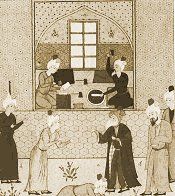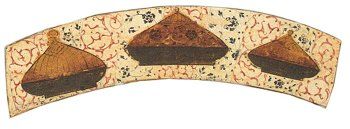Serving the Guest: A Sufi Cookbook
Essays | Recipes | Gallery
A number of early Persian and Arabic cookbooks from the 10th-19th centuries have survived, representing the haute cuisine of caliphs and princes, and all of them written by men. The culinary practices of women, who prepared (and still do prepare) most everyday food, and who traditionally transmitted their recipes orally, are harder to ascertain. The "historic recipes" presented here cannot therefore be regarded as exactly reflecting common cuisine. Rather, they are approximations of dishes referred to in tradition and literature, based on available historical documentation and contemporary formulas that demonstrate the perpetuation of ingredients and techniques over hundreds of years.
The aristocratic cuisine is notable for its lavishness, the variety made possible by vast kitchen staffs, and the leisure which afforded the development of highly refined taste and an aesthetic approach to food. Such privilege was enjoyed for feasts at those Mevlevi centers, or tekkes, which were supported by substantial endowments and occasionally entertained guests of high social rank. Surviving 16th century records from the philanthropic institutions known as imarets, list quantity purchases of wheat, rice, prunes, dried shredded pears, raisins, currants, almonds, apricots, figs and plums, sheepstail fat and clarified butter, onions, dried beans, honey and grape syrup, and the spices cumin, coriander, saffron and pepper, for long-term storage. Wheaten foods, notably bread and breakfast porridge, and grain-based soups were served every day, and were the mainstay of the Mevlevis' simple diet of two meals per day. More costly rice was reserved for Fridays and feast days.
Mevlana wrote in Persian, and referred to many specific foods, some of which have survived to the present day, in name if not in every detail of their preparation. Some of his references include chickpeas; eggplant (Mevlana wasn't fond of it); spinach; onions, garlic and vinegar; wheat and barley; butter and buttermilk; pickles, peaches and pomegranates; lablabu, or roasted chick peas; the noodle dish tutmaj; yakhni, a generic term for lamb stew; kebab, roast meat; harisa-ye-rasida, a porridge made of grains and meat; boiled ox-feet; sanbusa, meat turnovers; beryani, a dish of rice, meat and vegetables; bulgur, cracked wheat; qadid, dried spiced meat; tharid, boiled meat or bread and gravy; lentils; rice pudding; sugar, sugar-cane and honey; luzina, nut candies; jowzina, sugared almonds; paluda, a dish of milk, flour and spices; kadayif, a pastry made of shredded wheat, nuts and syrup; and the much-beloved halvah, a generic word for a range of sweets for the most part based on fried flour.

Another source of historic culinary information is linguistic research, which has extracted words for many grain foods from Central Asian and Southwestern Turkic languages of the 14th-15th centuries. These foods include toasted and fried grain dishes; boiled grains and porridges; ovmach, a form of couscous; tutmach, thin noodles cooked with meat and yogurt; salma, another kind of flat soup noodle; and breads and cakes, ranging from fried dough, pancakes, flatbreads and fried jelly rolls, to the filled pie borak, lavash, and the precursor of fillo dough, yubqa.
from Serving the Guest: A Sufi Cookbook
Copyright © 1999, 2000 by Kathleen Seidel
Sources of previously published material by other authors used by permission, and print sources for images, may be found at http://www.superluminal.com/cookbook.
